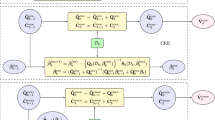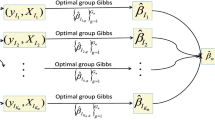Abstract
As the applications for modeling of big data and analysis advance in scope, computational efficiency faces greater challenges in terms of storage and speed. In many practical problems, a great amount of historical data is sequentially collected and used for online statistical modeling. For modeling sequential data, we propose a sequential linear regression method that extracts essential information from historical data. This carefully selected information is then utilized to update a model according to a sequential estimation scheme. With this technique, the earlier data no longer needs to be stored, and the sequential updating is computationally efficient in speed and storage. A weighted strategy is introduced on the current model to determine the impact of data from different periods. When compared with estimation methods that use historical data, our numerical experiments demonstrate that our solution increases the speed while decreasing the storage load.



Similar content being viewed by others
References
Philip Chen, C., Zhang, C.Y.: Data-intensive applications, challenges, techniques and technologies: a survey on big data. Inf Sci 275, 314–347 (2014)
Chen, J., Chen, Y., Du, X., Li, C., Lu, J., Zhao, S., Zhou, X.: Big data challenge: a data management perspective. Front. Comput. Sci. 7(2), 157–164 (2013)
Menard, S.: Applied Logistic Regression Analysis, vol. 106. Sage, Thousand Oaks (2002)
Hastie, T., Tibshirani, R.: Discriminant adaptive nearest neighbor classification. IEEE Trans. Pattern Anal. Mach. Intell. 18(6), 607–616 (1996)
Mayer-Schönberger, V., Cukier, K.: Big Data: A Revolution that will Transform How We Live, Work and Think. Houghton Mifflin Harcourt, Boston (2013)
Russom, P., et al.: Big data analytics. TDWI Best Practices Report, Fourth Quarter (2011)
Sathiamoorthy, M., Asteris, M., Papailiopoulos, D., Dimakis, A.G., Vadali, R., Chen, S., Borthakur, D.: Xoring elephants: novel erasure codes for big data. In: Proceedings of the VLDB Endowment, vol. 6, pp. 325–336. VLDB Endowment (2013)
Chapman, D.G.: The estimation of biological populations. Ann. Math. Stat. 24, 1–15 (1954)
Wald, A.: Sequential tests of statistical hypotheses. Ann. Math. Stat. 16(2), 117–186 (1945)
Stein, C.: A two-sample test for a linear hypothesis whose power is independent of the variance. Ann. Math. Stat. 16(3), 243–258 (1945)
Robbins, H., Monro, S.: A stochastic approximation method. Ann. Math. Stat. 22, 400–407 (1951)
Hastie, T., Tibshirani, R., Friedman, J., Franklin, J.: The elements of statistical learning: data mining, inference and prediction. Math. Intell. 27(2), 83–85 (2005)
Varian, H.R.: Big data: new tricks for econometrics. J. Econ. Perspect. 28(2), 3–27 (2014)
Chen, H., Chiang, R.H., Storey, V.C.: Business intelligence and analytics: from big data to big impact. MIS Q. 36(4), 1165–1188 (2012)
Bishop, C.M., et al.: Pattern Recognition and Machine Learning, vol. 1. Springer, New York (2006)
Wald, A.: Sequential Analysis. Courier Corporation (1973)
Aitken, A.C.: Iv.on least squares and linear combination of observations. Proc. R. Soc. Edinb. 55, 42–48 (1936)
Farin, G.E.: Curves and Surfaces for CAGD: A Practical Guide. Morgan Kaufmann, San Francisco (2002)
Pozrikidis, C.: Numerical Computation in Science and Engineering, vol. 307. Oxford University Press, New York (1998)
Hoerl, A.E., Kennard, R.W.: Ridge regression: biased estimation for nonorthogonal problems. Technometrics 12(1), 55–67 (1970)
Le Gall, F.: Powers of tensors and fast matrix multiplication. In: Proceedings of the 39th International Symposium on Symbolic and Algebraic Computation, pp. 296–303. ACM (2014)
Acknowledgments
We would like to thank the anonymous reviewers for their constructive and valuable comments.
Author information
Authors and Affiliations
Corresponding author
Additional information
This work was supported by the National Natural Science Foundation of China (Nos. 11171322 and 11426236) and the Fundamental Research Funds for the Central Universities (WK0010000051).
Rights and permissions
About this article
Cite this article
Zhang, QT., Liu, Y., Zhou, W. et al. A Sequential Regression Model for Big Data with Attributive Explanatory Variables. J. Oper. Res. Soc. China 3, 475–488 (2015). https://doi.org/10.1007/s40305-015-0109-8
Received:
Revised:
Accepted:
Published:
Issue Date:
DOI: https://doi.org/10.1007/s40305-015-0109-8
Keywords
- Big data
- Attributive explanatory variables
- Periodic spline
- Weighted least squares
- Sequential estimation




